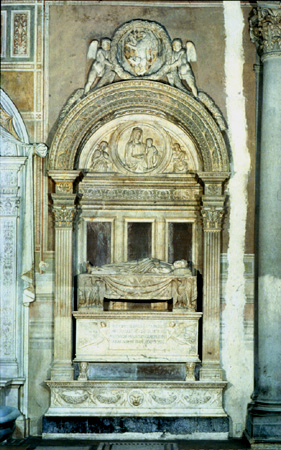11 Philology and the Bible
Art, Drama, Religion
The Nativity Scene (Presepio, Presepe)
1223: Francis of Assisi, Greccio
Bologna: 13th c Nativity Scene: Adoration of the Magi
Arnofo di Cambio, Presesepe (1280s), Rome, SMM
Benozzo Gozzoli, Adoration of the Magi, Palazzo Medici, Florence
Gothic cribs for Christmas re-enactments
Tableau Vivant
Laguna Beach Pageant of the Masters
https://thekidshouldseethis.com/post/tableaux-vivants-caravaggio-paintings
Cesare da Sesto, San Rocco (1523). Milan: Pinacoteca, Castello Sforzesco
Philology and the Bible
Some humanist contributions to studies of texts and language
handwriting and print fonts
editing, translation, publishing
A current ex: review of some modern Dante translations
historical studies of languages
forgeries of ancient texts and the discovery of forgeries by others
efforts to study critically the text of the bible itself
Today’s focus: critical study of texts

Leonardo Bruni, Tomb. Artist: Bernardo Rossellino, 1409-1464
Leonardo Bruni (c. 1370-1444) and translations of Aristotle
chancellor of Florence (from 1427)
translations: Plato: Phaedo, Crito, Apology, Phaedrus, Gorgias
Aristotle: Economics, Politics, Ethics (1416-17)
Alonso de Cartagena
barbarisms
Lorenzo Valla (ca 1407-57)
grew up in Rome; worked in Pavia, Milan, Naples, Rome
most famous book in his lifetime: Elegances (Elegantiae linguae latinae)
“Best” Latin: style used from Cicero to Quintilian
philosophical writings: language
Annotations on NewTestament (ca. 1450); On the Donation of Constantine (1440)
Donation (Declamatio): Vatican manuscript
anachronism: Constantinople
word usage in the 4th century: tiara (phrygium)
writing style: turns of phrase apparently from Vulgate Bible (Jerome born c. 345)
Carolingian forgery
Annotations on NT—ca 1450
published by Erasmus: 1505
focus on the divine word (not theology)
study of Vulgate in the light of the Greek
levels of annotations:
- grammatical
- stylistic
- philosophical
Giannozzo Manetti (1396-1459)
worked for Medici, then as secretary for Nicholas V
new translation of the Greek New Testament based on Greek sources
Study of Hebrew
Desiderius Erasmus 1469-1536

Erasmus, portrait, Hans Holbein the younger, 1497-1543
Jerome and Erasmus
ad fontes
Jerome and Basil (Basil translated by Bruni)
Biography
Brothers of Common Life
Augustinian
university at Paris; taught Latin: Adages, Colloquies
First trip to England 1499; Thomas More
“primitive theology”
England again 1509-14. Praise of Folly
Jerome Opera omnia 1516; contributed to editions of Augustine, Ambrose, Basil, other Church Church Fathers
Edition of Greek New Testament (1516; 2nd ed 1519); Complaint of Peace 1517
Other editions, translations
Annotations on New Testament
- 1504 discovered Valla’s manuscript, published 1505
- 1516 Greek NT with an emended Vulgate; annotations
Contexts for these tasks
- commercial: printing, book market
- editions of ancient writers, pagan and Christian
- renewed interest in Church fathers, in Bible
- new approaches to reading old sources: better historical understanding

